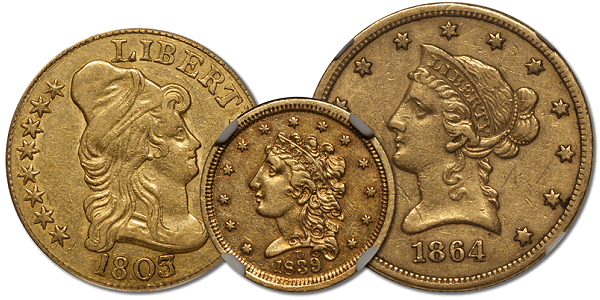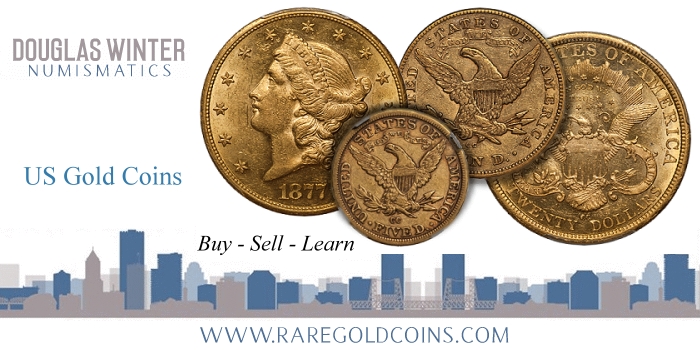
By Doug Winter – RareGoldcoins.com
CoinWeek Content Partner ……
As is tradition at DWN, at the end of every year we summarize our experiences buying and selling choice and rare United States gold coins and attempt to predict what will be the “hot” and “not so hot” areas in the market. We base this primarily on our experience: determining what sells quickly off our website (www.raregoldcoins.com), which coins get multiple orders, what sort of feedback we get from collectors, the want lists we receive, our experiences(s) at shows and auctions, and good old “gut instinct.”
I would regard 2015 as a mixed year for the coin market but an above-average market for dated gold. Unlike such market areas as Gem Seated and Barber silver coinage, Colonials, Large Cents and early type, there were monumental offerings the size and scope of Pogue, Gardner, Kendall, Partrick, Twin Leaf, Newman, Greensboro and more which had a huge impact on the supply of many rare and expensive United States coins. There haven’t been any really profound offerings of dated gold flooding the market in a number of years and as a result the supply and demand ratio is still manageable. If anything (and I want to be careful here about not “getting what I wish for…”) the supply of nice, DWN-quality dated gold is lower than ever.
What are some of the areas which, in my opinion, look to be hot in 2016?
1. Collector Quality Dahlonega Coinage
In 2015, nearly every choice, original collector quality Dahlonega gold coin I had in stock sold quickly and typically with multiple orders. (Note: by “collector quality” I mean coins in the VF-AU range with natural color and surfaces, preferably but not necessarily with CAC approval.) These were coins priced in the $2,000-7,500 range and in all three of the major denominations struck at this mint.
While collecting by date has fallen out of favor in certain series, it is still popular with Dahlonega gold. Not only were affordable common dates popular in 2015, so were better dates. The coins which appeared to have been most popular with those with multiple levels of demand, especially the 1839-D quarter eagle, the 1838-D half eagle, and the more expensive but super-popular 1861-D issues.
I see Dahlonega gold continuing to be very popular with collectors in 2016 and beyond. It remains comparatively affordable, it has no unbuyable key issues, and there are numerous ways to collect it.
2. Civil War Gold Coinage
When I began touting the collectability of Civil War gold coinage in 2010, I had no idea that so many new collectors would enter the market and that so many other dealers would follow my lead. Today, there are dozens of serious Civil War collectors and their collections range from simple (P Mint double eagles) to all-encompassing (all coins struck at the various U.S. mints from 1861 through 1865).
Probably the only things holding this area back in 2016 and beyond are a lack of availability and rapid rise(s) in price which have knocked out many early adapters in this field.
That said, I see continued strong demand for Civil War gold in 2016, especially for the really rare issues such as the 1863 and 1864 quarter eagles, the 1864-S half eagle, the 1863 and 1864 eagles ,and the 1861-S Paquet double eagle.
3. Affordable Early Gold
Whenever I list a coin such as an EF45 early quarter eagle or a nice AU50 early half eagle on my website, it typically is ordered within a few hours. Early gold is expensive but its appeal is widespread and even if a collector is not planning to specialize, the thought of obtaining a nicely toned, original coin in the $7,500-15,000 range is very tempting to numerous collectors.
The market for these coins tends to be very picky and less interested in the date of a specific coin than its appearance. A coin which is approved by CAC and which has deep, natural color and real eye appeal is an easy sell. A washed-out, processed coin—even one which is a better date or an important type—is hard to sell.
Proof of this can be seen by market pricing. As an example, a really choice AU55 1803/2 half eagle is worth more than a mediocre example of the same date in AU58 and is probably equal in value to a mediocre MS60 to MS61 coin.
4. No Motto Liberty Head Half Eagles
2015 was a memorable year for me in many ways. One series which I had an especially fruitful year was No Motto half eagles. I handled numerous finest known and Condition Census coins and began working on a number of important sets and subsets.
No less than five mints made half eagles between 1839 and 1866 and each of these series has a strong collector base. One thing I like about No Motto half eagles is that you get a lot of bang for your buck. $2,500-5,000 can buy you an interesting coin and $10,000-20,000 will buy you something which is literally museum quality. Many collectors became aware of this in 2015 and, as I’ve already written, half eagles became the new eagles in 2015 which became the new double eagles in 2010.
I see nothing but good things for No Motto half eagles in 2016 and beyond. I’ve already touched on Dahlonega issues above but I see strength in the New Orleans half eagles, certain San Francisco issues and even the heretofore ignored Philadelphia issues.
Runners Up:
Other series I see positive things for in 2016 include Type Two gold dollars, Gem CAC type gold, certain three dollar gold pieces, Indian Head half eagles and eagles, and collector quality Classic Head gold.
Now, to the other side of the coin. What are some of the areas which I think will be cold in 2016?
1. Indian Head Quarter Eagles
For years, the market for this series was controlled by a Texas marketing firm. It was controlled in an orderly fashion and prices rose accordingly, in spite of seemingly endless gradeflation at the high-end of the spectrum.
A few years ago, this firm basically stopped supporting the market they created and prices have crashed, while the supply of MS64’s and MS65’s seems never-ending.
Until someone steps into the void left by the Texas firm and markets this series as it was in the past, Indian quarter eagles are destined to be deader than the proverbial doorknob. If you are a daring contrarian, buy some at current levels but stick to those which have been approved by CAC and vetted by a knowledgeable expert.
2. Commemorative Gold Coinage
There may be another series of U.S. gold coinage which has shown greater price depreciation over the years than commemoratives gold dollars and quarter eagles, but I would be hard-pressed to name it.
This series hit unparalleled highs in 1989 and has been on a death spiral ever since. I’ve noticed some half-hearted efforts to revive this series in the last year and some very clever dealers have taken positions in certain issues.
But the marketing used to sell these coins since 1989 is wrong. It always revolves around the “1989 price of $4500 versus today’s price of $750.” This is flawed and antiquated and it will never work. Until someone else figures a more clever way to market these coins, they are like to stay in the Numismatic Dumpster.
3. Common Coins in Uncommon Grades
You can justify the concept of paying $10,000 for a very common date Lincoln Cent (say a 1935-S) in a very high grade (say MS68) due to the extreme popularity of the series and the number of competitive Registry collectors. I’m not saying it’s a good idea and I would never, ever sell a $10,000 1935-S Cent to a valued customer.
But even something as nutty as this makes more sense than spending $25,000+ on a common date Liberty Head quarter eagle in PCGS/CAC MS68 when the same coin can be had for $4,000+ in PCGS/CAC MS67, and for $1,750 in PCGS/CAC MS66. The Lincoln Cent series is avidly collected by date while the Liberty Head quarter eagle series is not.
There is, of course, a rational exception to this rule and this is if you seek one single ultra-high grade common gold coin for type purposes. In this sense, I could see spending the big bucks for, say, an MS68 Liberty Head quarter eagle. But if you do this, make certain the coin is all there and it isn’t a barely-made-it example for the grade.
It is important that the collector not associate “common coins in uncommon grades” with “uncommon coins in uncommon grades.” By this, I mean a coin which is rare in all grades (usually 100 or fewer known) in an uncommonly high grade for the specific issue. These coins were hot in 2015 and should remain so in 2016 as well.
4. Common Date Type One Liberty Head Double Eagles
I don’t think anyone reading this blog would be surprised by numbers one through three on the cold in 2015 list. Item number four might be more of a surprise, especially given how hot this series was as recently as two years ago.
A number of factors conspired to make common date Type Ones an unwanted area of the rare date gold market in 2015: abundant supply, slightly decreased demand and, most importantly, a lot of unattractive, overgraded coins hitting the market. This made a number of common date Philadelphia and San Francisco Type Ones drop 10-20% in price this year.
It is important not to misinterpret my last statement. Nice, fresh, original common Type Ones are still in demand and better dates in this series remain in very high demand, especially New Orleans and Civil War issues.
If you are thinking of starting a set of Type Ones, this seems like a very good time to do this, given the drop in prices.

About Doug Winter
 Doug has spent much of his life in the field of numismatics; beginning collecting coins at the age of seven, and by the time he was ten years old, buying and selling coins at conventions in the New York City area.
Doug has spent much of his life in the field of numismatics; beginning collecting coins at the age of seven, and by the time he was ten years old, buying and selling coins at conventions in the New York City area.
In 1989, he founded Douglas Winter Numismatics, and his firm specializes in buying and selling choice and rare United States coins, especially US gold coins and all branch mint material.
Recognized as one of the leading specialized numismatic firms, Doug is an award winning author of over a dozen numismatic books and the recognized expert on US Gold. His knowledge and exceptional eye for properly graded and original coins has made him one of the most respected figures in the numismatic community and a sought after dealer by collectors and investors looking for professional personalized service, a select inventory of impeccable quality and fair and honest pricing. Doug is also a major buyer of all US coins and is always looking to purchase collections both large and small. He can be reached at 214-675-9897.
Doug has been a contributor to the Guidebook of United States Coins (also known as the “Redbook”) since 1983, Walter Breen’s Encyclopedia of United States and Colonial Coins, Q. David Bowers’ Encyclopedia of United States Silver Dollars and Andrew Pollock’s United States Pattern and Related Issues
In addition he has authored 13 books on US Gold coins including:
- Gold Coins of the New Orleans Mint: 1839-1909
- Gold Coins of the Carson City Mint: 1870 – 1893
- Gold Coins of the Charlotte Mint: 1838-1861
- Gold Coins of the Dahlonega Mint 1838-1861
- The United States $3 Gold Pieces 1854-1889
- Carson City Gold Coinage 1870-1893: A Rarity and Condition Census Update
- An Insider’s Guide to Collecting Type One Double Eagles
- The Connoisseur’s Guide to United States Gold Coins
- A Collector’s Guide To Indian Head Quarter Eagles
- The Acadiana Collection of New Orleans Coinage
- Type Three Double Eagles, 1877-1907: A Numismatic History and Analysis
- Gold Coins of the Dahlonega Mint, 1838-1861: A Numismatic History and Analysis
- Type Two Double Eagles, 1866-1876: A Numismatic History and Analysis
Finally Doug is a member of virtually every major numismatic organization, professional trade group and major coin association in the US.
If you are interested in buying or selling classic US coins or if you would like to have the world’s leading expert work with you assembling a set of coins? Contact Doug Winter at (214) 675-9897 or by email at [email protected].




